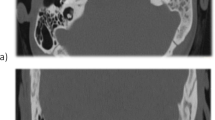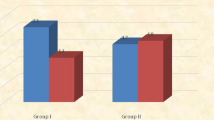Abstract
Squamous chronic otitis media (COM) implies formation of a retraction pocket (inactive form) or frank cholesteatoma (active form) in pars tensa or pars flaccida of tympanic membrane. A retraction pocket or frank cholesteatoma are believed to occur due to tubal dysfunction. The present study was undertaken to investigate the pattern of mastoid pneumatisation and Eustachian dysfunction by dynamic slow motion videoendoscopy (DSVE) in cases of both, active and inactive type of squamous chronic otitis media (COM). 52 patients (65 ears) comprising of twenty-six ears with pars flaccida squamous disease and 39 ears with Pars Tensa squamous disease were enrolled for the study. DSVE findings, in terms of grade and type of Eustachian dysfunction were noted. Mastoid pneumatization pattern on CT-scans, and peroperative status of mastoid pneumatisation, especially contracted mastoid with anteriorly placed sigmoid sinus or low lying dura were also recorded for every case while performing tympano-mastoidectomy. Primary sclerotic/diploic type of mastoid pneumatisation pattern and Eustachian dysfunction were found to have inverse relationship in the cases of squamous otitis media. Eustachian dysfunction, diagnosed on DSVE, had significant association with both pars flaccida (P = 0.0001) and pars tensa disease (P = 0.0007). Primary sclerotic or diploic mastoid were found to be more common in ears with pars flaccida squamous disease than pars tensa COM (46.15% vs. 38.46%, P < 0.05).






Similar content being viewed by others
References
Sudhoff H, Tos M (2000) Pathogenesis of attic cholesteatoma: clinical and immunohistochemical support for combination of retraction theory and proliferation theory. Am J Otol 21(6):786–792
Sudhoff H, Tos M (2007) Pathogenesis of sinus cholesteatoma. Eur Arch Otorhinolaryngol 264(10):1137–1143
Welkoborsky HJ (2011) Current concepts of the pathogenesis of acquired middle ear cholesteatoma. Laryngorhinootologie 90(1):38–48 (quiz 49–50)
Maniu A, Harabagiu O, Perde Schrepler M, Cătană A, Fănuţă B, Mogoantă CA (2014) Molecular biology of cholesteatoma. Rom J Morphol Embryol 55(1):7–13
Sadé J, Fuchs C, Luntz M (1996) The pars flaccida middle ear pressure and mastoid pneumatization index. Acta Otolaryngol 116(2):284–287
Iqbal IZ, Watson C (2016) A study of mastoid pneumatisation and the presence of cholesteatoma in 393 patients. J Laryngol Otol 130(1):66–68
Lee DH, Jung MK, Yoo YH, Seo JH (2008) Analysis of unilateral sclerotic temporal bone: How does the sclerosis change the mastoid pneumatization morphologically in the temporal bone? Surg Radiol Anat 30(3):221–227
Jain S, Gupta M, Singh P (2016) Dynamic video endoscopy in Eustachian tube dysfunction: is it better than impedance audiometry. Innov J Med Health Sci 6(3):88–92
Gupta M, Jain S, Gaurkar S, Deshmukh PT (2015) Role of dynamic slow motion video endoscopy in etiological correlation between eustachian dysfunction and chronic otitis media: a case-control study. Indian J Otol 21:19–24
Shatz A, Sadé J (1990) Correlation between mastoid pneumatization and position of the lateral sinus. Ann Otol Rhinol Laryngol 99(2 Pt 1):142–145
Toros SZ, Karaca CT, Habeşoğlu TE, Noşeri H, Ertugay CK, Naiboğlu B, Egeli E (2010) Is there a relation between mastoid aeration and Körner’s septum? Eur Arch Otorhinolaryngol 267(10):1523–1526
Sadé J, Fuchs C (1997) Secretory otitis media in adults: II. The role of mastoid pneumatization as a prognostic factor. Ann Otol Rhinol Laryngol 106(1):37–40
Author information
Authors and Affiliations
Corresponding author
Ethics declarations
Conflict of interest
The authors declares that they have no conflict of interest.
Ethical Approval
All procedures performed in studies involving human participants were in accordance with the ethical standards of the institutional and/or national research committee and with the 1964 Helsinki declaration and its later amendments or comparable ethical standards.
Rights and permissions
About this article
Cite this article
Jain, S., Singh, P., Methwani, D. et al. Role of Eustachian Dysfunction and Primary Sclerotic Mastoid Pneumatisation Pattern in Aetiology of Squamous Chronic Otitis Media: A Correlative Study. Indian J Otolaryngol Head Neck Surg 71 (Suppl 2), 1190–1196 (2019). https://doi.org/10.1007/s12070-018-1259-x
Received:
Accepted:
Published:
Issue Date:
DOI: https://doi.org/10.1007/s12070-018-1259-x




